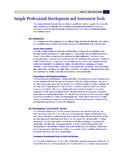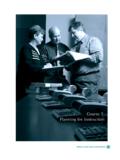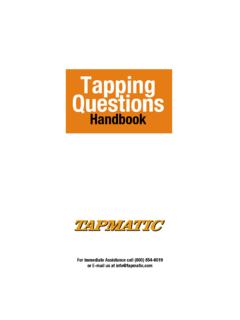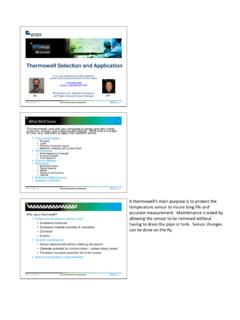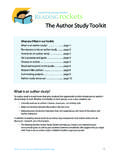Transcription of Course 7: Learning Styles - Washington State …
1 Learning Styles Course 7: Learning Styles Learning Styles Learning Styles Skill Standard: B: Develop outcomes, assessments, and curriculum Key Activity: B2: Create, evaluate and modify curriculum Skill Standard: D: Provide student instruction Key Activities: D2: Provide individual and group instruction D3: Initiate, develop, and implement student assessments Skill Standard: E: Provide support and guidance to students Key Activity: E1: Respond to student needs . Course DESCRIPTION: .. The receiving and processing of information varies among learners. Individuals have their . own preferred method of Learning , a wide range of intelligences, and attitudes about Learning .. and the environment in which the Learning occurs.
2 Each of these areas of learner individual- . ity plays a significant role in instructional outcomes.. In this Course , professional-technical instructors will be introduced to the theories of Learning . Styles , multiple intelligences, Learning types and environmental affects on Learning . Instructor- .. learners will identify their own Learning attitudes, environment preferences, Learning Styles and .. intelligences and begin to identify the Learning profiles of their students.. This Course will facilitate instructors to create Learning environments that are most conducive . to optimal Learning and to implement teaching/ Learning strategies that engage a variety of .. Learning Styles for instructional success.. Learning OUTCOMES: The instructor-learner will.
3 Recognize the diversity of intelligences and Learning Styles , modeling a positive Learning .. attitude, while respecting and encouraging successful Learning communities.. Create Learning environments that are conducive to optimal Learning and implement . Learning strategies that engage a variety of Learning Styles for instructional success.. Demonstrate sensitivity to individual Learning needs and the Learning environment and .. show flexibility and spontaneity in meeting the needs of diverse Learning Styles .. OUTCOMES ASSESSMENT: . Assess their own Learning Styles , Learning attitudes, intelligences and Learning .. environment preferences and how these impact their personal teaching style.. Ascertain the Learning Styles , intelligences and preferences of students in their classes to.
4 Modify instruction.. Design a clear, concise lesson plan that successfully demonstrates use of the four .. different Learning Styles and multiple intelligences theories.. Develop specific activities that facilitate students and others to support and respect . individual differences in Learning Styles and intelligences.. Design a Learning environment that engages diverse learners and fosters a positive .. CURRICULUM GUIDE: Learning Styles . Learning Styles Learning atmosphere and attitude and encourages students to explore new Learning Styles .. to broaden their Learning potential. PERFORMANCE INDICATORS: .. The Learning environment is optimized for successful and enjoyable Learning experiences.. Students are actively engaged in the Learning experience and encouraged to respond to.
5 Information using their most preferred Learning style.. Collaboration within small groups is promoted using the four Learning Styles to mentor .. one another for clarification of information.. Classroom reflects a positive Learning environment with use of peripherals, sound, . comfortable seating, appropriate breaks, temperature, music, graphics, etc.. Visual aids, auditory aids, kinesthetic models, and process journals throughout the .. Course to address Learning Styles of diverse students are incorporated.. A wide variety of Learning strategies that recognize diversity in Learning is implemented.. Students move out of Learning in isolation into collaborative working teams and .. community Learning environments.. The physical Learning environment is carefully designed to enhance Learning , reduce.
6 Anxiety, promote curiosity, engage the learner, and encourage a playful attitude about .. Learning .. Flexibility within the instructional framework to meet the needs of all Learning Styles is . demonstrated.. Brain-compatible Learning principles are incorporated throughout the Course and .. program.. KNOWLEDGE AND SKILLS: The instructor-learner will gain: .. Knowledge of and sensitivity toward diverse Learning Styles .. Knowledge of multiple intelligences.. Understanding and application of teaching and Learning strategies for diverse learners.. Ability to develop and modify a Learning environment for diverse learners.. Understanding of various personality and Styles inventories.. Knowledge of effective group activities.
7 Knowledge of brain-based theories of development for Learning .. SUGGESTIONS FOR Learning ENVIRONMENT: .. Learning Styles and Multiple Intelligences posters are displayed along with positive . motivational Learning quotes that are changed frequently.. Course outline, competencies, outcomes and daily plan are displayed in colorful, clear, .. concise posters, as applicable.. Appropriate equipment and materials are available for kinesthetic learners to reduce .. anxiety at beginning of Course .. Plants, fresh flowers, or some form of nature is included within the classroom to .. support the naturalist intelligence.. Materials such as colored pens, colored paper, scissors, and clay are readily available .. for class projects.
8 Use of music during breaks, creative processing, jingles for memory hooks and to . activate both hemispheres of the brain.. Small group Learning sessions are grouped by Learning Styles , intelligences, and .. preferences and grouped randomly to encourage and celebrate diversity.. Learning Styles Learning ATTITUDES. Essential Content Discussion Topics and Key Points Power of the mind How our beliefs affect our Learning . The synergistic brain; what we focus on, expands. Current brain research and new educational strategies. See Triune Brain Theory, attached. Silent saboteurs to Learning Identifying negative self-talk. Identifying negative body language. Identifying old belief systems. See How to Silence the Learning Saboteurs, attached.
9 Strategies for overcoming Permission to express negativity. the saboteurs Share journaling throughout Course . Meeting challenges, risk taking, appreciating errors. Redesigning Learning . Constructing new beliefs. Creating a success spiral. Learning communities. Visualization and breathing Introduce visualization techniques. as Learning tools Lowers stress, oxygenates brain for better Learning Seeing is believing, believing is achieving. See Uses of Mental Imaging and Learning , attached. Learning communities Moving from isolation to Learning community. Collaborating vs. competition. All assume leadership role. Incorporating all the intelligences. See Moving Students from Isolation to Group Work, attached.. Learning ACTIVITIES: The facilitating-instructor may use the following activities/assign.
10 Ments with instructor-learners.. Metaphors, anecdotes, testimonials, guest speakers, stories, humor, jokes, fairy tales, are .. used to relay concepts for global and auditory learners.. Frequent opportunities to stop instruction to talk about the Learning , share questions, .. concerns and relevant experiences are planned.. Periodic reviews and big-picture check-ups to review daily road map and global road .. map of the program are conducted to support analytical learners.. Window framing or other visual Learning strategies are used to facilitate sequential .. Learning , visual creativity, and long-term memory.. Reflective journaling for processing information and facilitating intra-personal learners is .. used.. Frequent change in group leadership focus.



